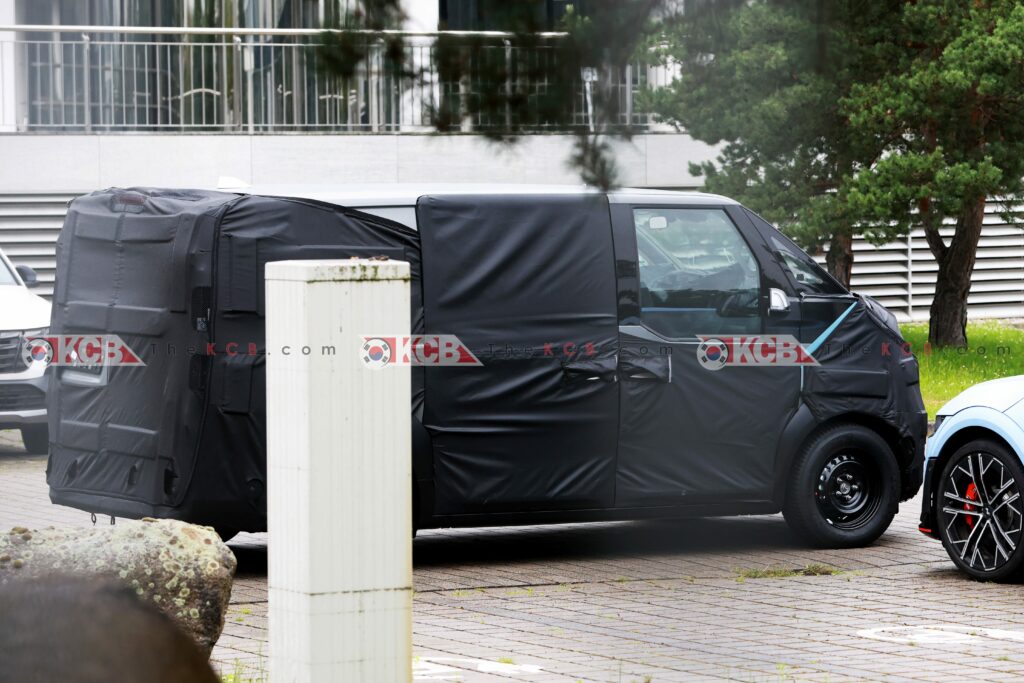Purpose-Built Vehicles (PBVs) are emerging as a revolutionary concept in the automotive industry. Now KIA and its upcoming KIA PV5 were spotted for the first time in and out in South Korea thanks to our colleagues at Healer TV, apparently just downloaded from the truck and ready to start testing with Volkswagen’s ID. Buzz as benchmark. Kia’s first PBV is expected to be released during the first quarter of 2025.
What is a PBV?
PBVs come in different sizes—small, medium, and large—tailored to specific functions. Kia’s upcoming medium-sized PBV, the ‘PV5’, is set to debut next year, featuring the dedicated ‘e-CCPM’ (Electric Complete Chassis Platform Module) developed by Hyundai Mobis. This integrated platform standardizes key components like the battery and drive motor, allowing the vehicle’s structure to be customized as needed .
The PV5 is comparable in size to a medium SUV and is designed to support various configurations, including a basic model, a high-roof delivery model optimized for logistics, and a chassis cab for cargo transport. This flexibility is achieved through software adjustments, enabling different forms and functions for diverse applications.
Technological Innovations in PBVs
Advanced technologies such as ‘by-wire’ systems and in-wheel motor systems are pivotal in enhancing the functionality of PBVs. By-wire systems, which control steering and braking electronically without mechanical linkages, offer greater design flexibility for the vehicle’s upper structure. In-wheel motor systems, where the electric drive system is integrated into the wheel, free up space within the vehicle for other uses.
Market Growth and Demand
The PBV market is expected to grow significantly, driven by the need for carbon-neutral solutions and the increasing popularity of electric vehicles. According to Hyundai Motor Group’s Global Management Research Institute, the global PBV market is projected to expand from 320,000 units in 2020 to 1.3 million units by 2025, and potentially reach 2 million units by 2030 .
This growth is supported by advancements in PBV technology, such as the commercialization of by-wire systems and skateboard platforms, which simplify the integration of various vehicle bodies and functionalities. These innovations are particularly beneficial for last-mile delivery services and ride-hailing applications, which are expected to drive demand for medium and large PBVs .
Major Automotive Players and Strategies
Global automakers are actively investing in the development and production of PBVs. Hyundai Motor Group is building dedicated PBV factories optimized for high-mix, low-volume production, minimizing raw material losses, and employing eco-friendly manufacturing processes. Kia aims to become a leader in the PBV market, with plans to establish the ‘Evo Plant’ in Hwaseong, capable of producing 300,000 PBVs annually by 2030 .
Other automakers like Volkswagen and General Motors are also exploring PBV applications. Volkswagen’s ‘MOIA+6’ and GM’s ‘EV600’ are examples of PBVs being tested for ride-sharing and logistics services, respectively .




Future Prospects
The versatility and adaptability of PBVs make them a promising solution for a range of applications, from urban transportation to commercial logistics. As the automotive industry continues to evolve towards more sustainable and flexible solutions, PBVs are poised to become a cornerstone of modern mobility, catering to the diverse needs of consumers and businesses alike.
In conclusion, the growth of the PBV market reflects a broader trend towards customization and sustainability in the automotive sector. With ongoing technological advancements and increasing investments from major automakers, PBVs are set to revolutionize the way we think about transportation.






